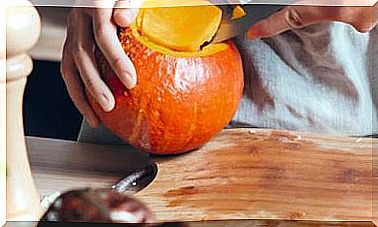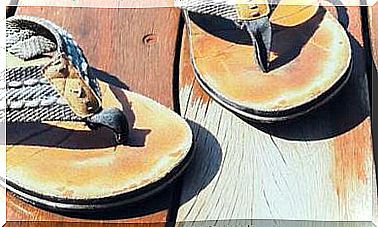Learning To Meditate In The City: 8 Exercises For Beginners
Everyday life offers endless opportunities to be aware of the richness and meaning that every moment treasures. We invite you to discover 7 ways to meditate in the city.

When we think of meditation, a scene comes to mind that brings serenity, tranquility, silence, isolation, outer and inner order. This beautiful and bucolic image contrasts with what we usually live in the middle of big cities.
So to experience meditation, do we have to go to a monastery? Or can you meditate amid the bustle ? In practice, it can and should be done. Every occasion is good to exercise in the attention in the present moment towards ourselves, towards others and towards the world in general.
The good meditator practices both at home and in secluded places, but exercises his meditative attitude on a daily basis. It would be useless to be wiser if it were not shared with the rest of humanity …
The more people meditate in the city … the better we will all feel and the less gray the atmosphere will be.
The city is and should be a privileged place to practice meditation. Of course, it is a challenge to maintain the proper attitude in traffic, in a traffic jam, when the bus is lost or when construction is done on the street where we work.
Being well when everything is beautiful and calm and the birds sing can be more or less easy, but feeling serene and anchored when the horns sound and the smoke does not allow you to breathe fully, has its what. There is nothing more exhilarating than living everyday life as an adventure of personal growth. In this article we will show you 7 different ways to meditate in the city.
How to meditate in the city
Meditating is getting in touch with the most essential and transcendent part of the person and the world. What we propose in this article are some exercises of attention to the present moment that will help you live your day to day with more serenity. They also provide a different vision of everyday life, deeper and more nuanced. The idea is inspired by Zen, which proposes living day to day as a meditative exercise. It is enough to know how to relax and go beyond the mental automatisms.
4 requirements of meditation in cities
Meditation implies an inner attitude that can be applied in any circumstance or act.
- Joy
There are those who confuse the spiritual, deep or transcendent with a serious and somewhat abstracted face. Rather, the good practitioner is someone who expresses joy and fulfillment. In Buddha images, he is always seen with a beautiful smile that comes from his being.
- Discretion
To meditate in the city it is not necessary to sit in precise postures that attract attention, or to do unusual practices or gestures. The best way to exercise is an inner attitude, little visible from the outside.
- Connection
Focusing on exercise does not mean isolating yourself from the world and its movements. It is quite the opposite: it means anchoring yourself in an internal central point so as not to get lost in the outside world and to be able to immerse yourself in everyday life in a natural way.
- Prudence
It is not advisable to do meditative exercises when cycling or riding in the city. It is advisable to be attentive to driving, paying full attention to what you are doing and the traffic. If you want to do certain types of exercises, take public transport or walk.
7 ways to meditate in the day to day of the city
These exercises are ideal for people who want to learn to meditate. Although, perhaps, even if you have never done meditation, you feel like trying these proposals. Go ahead, it ‘s a good way to start meditating. We will explore interesting, fun, and pragmatic ways to get the most out of our urban life while deepening our meditative practice.
Who dares?
1. Wash the dishes
Those who have read Zen texts know that one of the moments especially indicated to meditate in everyday life is the time to wash the dishes. It is very gratifying to concentrate on the gestures of washing and rinsing the dishes, as if there were nothing else to do next.
There are different ways to wash dishes. You can choose to fill two containers with water and soap and rinse or wash under running water, a less ecological option. Be that as it may, the important thing is to concentrate on each gesture, in each small movement, feeling the water, feeling the sponge or scourer, perceiving its friction on the plate and the pots …
For this, it is recommended to be attentive to the way you put your feet on the ground (it is important to be well supported on both feet). The position of the back should also be upright, without dropping over the sink, with a gentle incline without stiffness. Many times the breath is smoothly accompanying the movements.
If the dishwasher is used, there is always the option of loading it with full awareness of what is being done, carefully watching every movement … but it is not as exciting as the first option!
You can also take that attitude to the task of tidying up the kitchen, picking it up, cleaning the countertop … The moment when the kitchen is collected and the countertops clean is a special moment. If you are attentive you can feel a wave of deep and even mystical well-being.
2. Offer water to plants
Maybe we have a balcony or terrace. Maybe just some houseplants. The fact is that the act of watering them is a time that can become especially suitable for meditation. It is a gesture through which we nurture our vegetable friends and convey our love to them.
If you fill a watering can or container, you have to pay attention to its filling. That water is life for vegetables.
Be fully aware of the water falling from the shower, the hose, the saucepan, attentive to the amount of water that each pot needs … to the sound of the earth engulfing the liquid. To the reflections of the jet of water when leaving. The color of the earth. To the leaves of our plants… If you listen well, maybe you can hear the plants growing.
3. Sort a room
External order is often the reflection of internal order or disorder. Perhaps you have noticed that in moments of your life when you are more discouraged, it is lazy to order, things accumulate and internally it is difficult to find the right point to solve problems.
Simply put, when a house is in order, you breathe better in it. Of course, creativity creates disorder and there must be times when everything is turned upside down! Order should not be an obsession, but a pleasure.
You can take advantage of ordering to increase the feeling of order in your interior:
- Take each paper slowly.
- Place each book with full attention to what you do.
- Calmly walk across the room to put an object in place , feeling each step.
- Fold the clothes feeling each fold, with full awareness, thanking the existence and service that all these goods provide.
- See how each thing finds its place, how little by little our spirit is ordered to the rhythm of the exercise is very comforting.
The result is a feeling of being in order and, curiously, space is gained, external and internal.
Once the ordering exercise is done … you have to accept the continuous impermanence of situations and the flow of life. We must accept from our internal order that the children take things off the shelves again or that our partner change places what we had put so well.
That is when we will see that we have performed the exercise correctly, since those small external changes are not going to mess up our interior.
4. Open the door, close the door
Have you noticed how many times a day you open or close a door? Large walk-through doors, closet doors, miscellaneous container doors. Doors open or close. Many times one thing after the other.
How do you do it? Usually without paying attention. It is something banal. But when you are angry and slam the door out, it is no longer so banal: you want to leave a situation behind, show your anger, end something …
Opening the door is the first step to entering a new space. Many times we know what we will find on the other side. Sometimes not. But it always implies a transit.
Meditation is also a door that opens us to another way of being in the world. If we exercise in feeling the doorknob, if we exercise in opening ourselves internally to this experience of entering a new place or entering a certain attitude of attention in a familiar place, everything will change.
When you open a door, open it, feeling what you do. When you close the door, close it, feeling what you do. If the door is sliding, appreciate that curtain movement and the effect it produces.
The doors hide mysteries, they open us to them. They also protect us. We can lock ourselves behind a real or virtual door. Do we really know what is behind each door?
Let yourself be surprised, even if it is at home. Have you seen that there are “magic doors” that detect her presence and open before her? Sometimes they seem to resist openness and we feel like transparent… Other times we feel like kings before whom everything is made available for us to pass through. Others, simply grateful, because they facilitate the entrance to us.
Sometimes there are glass doors that are not visible. They are barriers that block our way and that demand that we not be confused. There are also revolving doors. Some with their own rhythm: you have to pace yourself to pass. Others have to be pushed and are heavy. There are doors to safes. With difficult combinations or hidden keys that hide secret treasures. There are doors that in fairy tales tell us not to open …
5. In the middle of the bustle, in the center of everything, free from everything
What is the busiest place in your city? One day you are there you can try the following.
Sit in a place where you are really in the middle of the crowd and noise. It can be a cafeteria, a terrace, a public bench or the railing of a staircase.
Once seated, settle inwardly. This means releasing the tensions of the shoulders, neck and back, while maintaining an upright posture. Feel your weight supported on the chair or wherever. Watch your breathing and allow it to become even calmer and deeper, without forcing.
Without making judgments of any kind, listen to what you hear, whatever you see ( don’t close your eyes ). Imagine that an immense whirlwind of people, noise and circulation revolves around you. You are in a central point that does not move. You see everything, you hear everything, but you are settled and still. Feel the serenity of this position.
Do not offer internal resistance to anything that is happening. The noise passes, the motorcycles, the cars, the conversations, the screams, they are there, but they do not bother you.
If you look closely, underneath all this there is an immutable silence that sustains everything. Even if you do not feel it, just knowing that it exists, you will live that moment in a different way.
When you feel that you are in contact with that inner central point, get up and walk normally through the crowd trying to maintain that state of connection with your inner center, but flowing between people, naturally and spontaneously. You are in the center of everything, in the center of the river of life, with its multiplicity and its apparent chaos, and at the same time you are present to your own presence.
6. Balancing on the subway
Do you take the subway frequently? Its swing is interesting to exercise rooting.
Rooting is feeling your own weight well installed on both feet, without holding onto any place (or anyone), with your feet slightly apart, hip-width apart. Feel the strong belly and the verticality well present, without being shrunken. To meditate you have to be well placed on the ground.
Meditation is not an escape from reality, but a seeing the everyday with new eyes to discover a fuller reality.
Let yourself be carried away by the rattle of the subway, attentive to the jolts and playing with the feeling of stability. Be careful not to disturb anyone if you lose your balance; in that case, you should be able to quickly catch yourself to the bar.
The breath can be brought to the belly to reinforce the feeling of strength in the hara, the body’s center of gravity and also the seat of ancient energy for traditional Far Eastern medicines.
Be careful not to go over the station! You should never be so focused that you lose sight of the environment, the people who are there and the stops that are happening.
7. queue
Waiting for a turn at a store or at the movie theater box office is a good time to work on tree meditation.
Feel your feet rooted in the ground. Let go of the twitching in the shoulders, lower back, buttocks and calves as best you can. Your feet are firmly planted on the ground. It is your weight that anchors you to the ground.
At the same time, a force takes you upwards, like a flow of sap that pushes you to grow internally and culminates in your crown. Get upright naturally and without stiffness.
While you feel like a tree that grows and grows, enjoying being there, do not lose sight of the people around you. Again, don’t isolate yourself to perform the exercise.
8. Look at people. Smile
The meditative attitude leads to concentration, but concentrating does not mean closing in on yourself. Much less dedicate selfishly to feeling good inside and not sharing.
Therefore, it is important to become aware of something that we do naturally on certain occasions, such as when we are in love or especially happy because we have accepted a work project that we like.
When you feel good on the inside, you naturally see the outside. But we can also favor and increase that inner well-being by letting our internal energy radiate outwards. For this, it is enough to not put barriers to natural movement.
Think of yourself as a warm, radiant pile of energy. To do this, do not contract, release unnecessary tensions, let your breath flow, relax your forehead and your mouth, release your jaw.
When you are calm, a smile appears on your face. Let it arise. Allow the pile of energy that you are to radiate warmth around you. Look at real people, seeing them when you come across them.
If a smile arises, let it express itself. It is a gift that you give to others and to yourself.
Think that the battery you contain is constantly recharged from an inexhaustible inner source and that the more you give, the more it will recharge. You will be surprised how people will respond to your exercise… and maybe you will be surprised how you will feel.
This proposal is suitable for any situation, of course, but it is especially interesting when you have a gray day.
Beginner mistakes
- When weekend meditation sessions or courses are organized, it is common for self-absorbed and wandering people to walk around . Often, if they come across a local, they refrain from responding to his greeting. This is a beginner’s attitude.
Meditating in the city does not mean giving a show, or shutting yourself up in the midst of people, or believing that a special energy protects us from all danger.
- Years ago a group of friends went to meditate in a park. Each one looked for a corner where they could sit in contemplation. One of my friends, dressed in strict white (he claimed that that color favored meditative practice), sat in a hollow in the rocks that he believed to be sheltered from gaze. He was actually sitting facing the park entrance and the only one who didn’t realize it was him. People entering were shocked to see someone sitting so blatantly meditating. Some of the group could not do more than stay to contemplate the show that was given and listen to the comments of the people …
- In the city of Jerusalem it occurred to me, many years ago, to go to meditate alone in the golden mosque. I sat on the carpet, in a cross-legged position and with my hands on my knees, I performed my mudra (position of the hands), closing my eyes. When I left after half an hour, my friends, who were wondering impatiently where I had gone, became very angry. Only then did I understand the unconscious of my deed.
- While waiting in line at the grocery store recently, my partner began to practice a yoga asana. Nobody saw it, but I laughed so hard that people turned to look at me.









